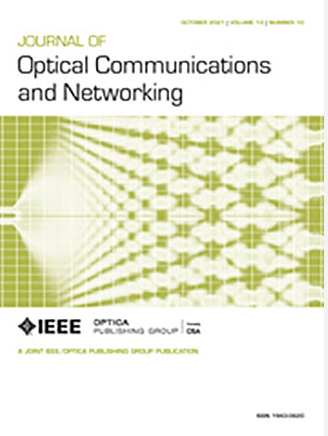Incremental planning with dual-fiber distributed Raman amplification in (C + L + S) networks
IF 4.3
2区 计算机科学
Q1 COMPUTER SCIENCE, HARDWARE & ARCHITECTURE
引用次数: 0
Abstract
Multi-band transmission is gaining traction as a promising solution for coping with the ever-increasing capacity demands of optical networks. In multi-band networks, long-term network planning must take into account the signal-to-noise ratio (SNR) degradations caused by interchannel stimulated Raman scattering arising when multiple lightpaths provisioned in the extended spectrum bands propagate in the same fiber. To avoid these degradations, in this study, we investigate the benefits of selectively upgrading a subset of the fiber spans with an additional fiber, which allows us to separate the spectrum bands and apply dual-fiber distributed Raman amplification (DF-DRA) in a C + L + S system. The deployment of DF-DRA, combined with EDFAs for the C- and L-bands and TDFAs for the S-band, reduces the overall amplification noise figure, thereby improving the SNR of lightpaths. Additionally, the separation of spectrum bands reduces pump-to-pump and signal-to-signal power transfer, further contributing to SNR improvement. We develop a numerical solver for setting the optimal Raman pump configurations, and we propose different placement strategies for hybrid EDFA/TDFA-Raman amplification and 3R regenerators. Our extensive numerical simulations on incremental traffic show that DF-DRA-enabled multi-band networks can yield up to a complete elimination of 3R regenerators by upgrading 30% of the network spans while having up to a 35% throughput increase.(C + L + S)网络中双光纤分布式拉曼放大的增量规划
多频带传输作为一种很有前途的解决方案,正受到越来越多的关注,以应对日益增长的光网络容量需求。在多波段网络中,长期网络规划必须考虑到在同一光纤中传播扩展频谱带中的多条光路所产生的通道间受激拉曼散射所导致的信噪比(SNR)下降。为了避免这些退化,在本研究中,我们研究了用额外的光纤选择性升级光纤跨度子集的好处,这使我们能够在C + L + S系统中分离频谱带并应用双光纤分布式拉曼放大(DF-DRA)。DF-DRA的部署,结合C波段和l波段的edfa和s波段的tdfa,降低了总体放大噪声系数,从而提高了光路的信噪比。此外,频谱带的分离减少了泵到泵和信号到信号的功率传输,进一步提高了信噪比。我们开发了一个数值求解器来设置最佳拉曼泵配置,并提出了混合EDFA/ tdfa -拉曼放大和3R再生器的不同放置策略。我们对增量流量的广泛数值模拟表明,启用df - dra的多频带网络可以通过升级30%的网络跨度来完全消除3R再生器,同时吞吐量增加35%。
本文章由计算机程序翻译,如有差异,请以英文原文为准。
求助全文
约1分钟内获得全文
求助全文
来源期刊
CiteScore
9.40
自引率
16.00%
发文量
104
审稿时长
4 months
期刊介绍:
The scope of the Journal includes advances in the state-of-the-art of optical networking science, technology, and engineering. Both theoretical contributions (including new techniques, concepts, analyses, and economic studies) and practical contributions (including optical networking experiments, prototypes, and new applications) are encouraged. Subareas of interest include the architecture and design of optical networks, optical network survivability and security, software-defined optical networking, elastic optical networks, data and control plane advances, network management related innovation, and optical access networks. Enabling technologies and their applications are suitable topics only if the results are shown to directly impact optical networking beyond simple point-to-point networks.

 求助内容:
求助内容: 应助结果提醒方式:
应助结果提醒方式:


